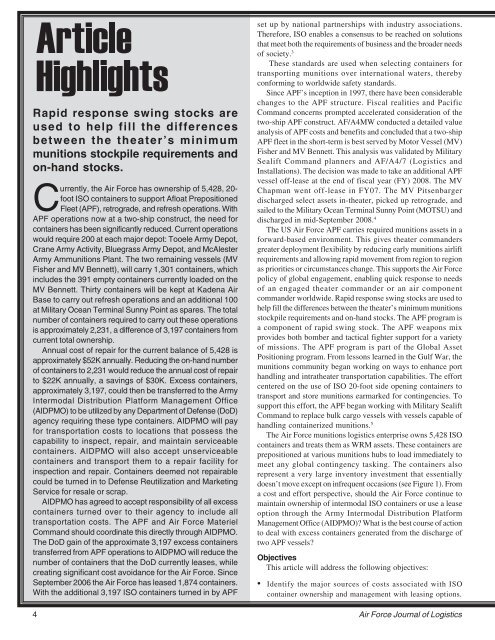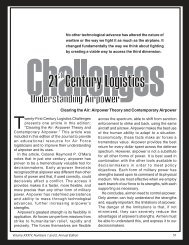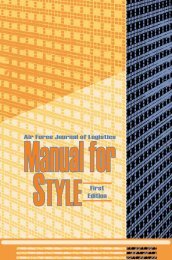Vol 32 No 4 - AF Logistics Management Agency
Vol 32 No 4 - AF Logistics Management Agency
Vol 32 No 4 - AF Logistics Management Agency
Create successful ePaper yourself
Turn your PDF publications into a flip-book with our unique Google optimized e-Paper software.
Rapid response swing stocks are<br />
used to help fill the differences<br />
between the theater’s minimum<br />
munitions stockpile requirements and<br />
on-hand stocks.<br />
Currently, the Air Force has ownership of 5,428, 20foot<br />
ISO containers to support Afloat Prepositioned<br />
Fleet (APF), retrograde, and refresh operations. With<br />
APF operations now at a two-ship construct, the need for<br />
containers has been significantly reduced. Current operations<br />
would require 200 at each major depot: Tooele Army Depot,<br />
Crane Army Activity, Bluegrass Army Depot, and McAlester<br />
Army Ammunitions Plant. The two remaining vessels (MV<br />
Fisher and MV Bennett), will carry 1,301 containers, which<br />
includes the 391 empty containers currently loaded on the<br />
MV Bennett. Thirty containers will be kept at Kadena Air<br />
Base to carry out refresh operations and an additional 100<br />
at Military Ocean Terminal Sunny Point as spares. The total<br />
number of containers required to carry out these operations<br />
is approximately 2,231, a difference of 3,197 containers from<br />
current total ownership.<br />
Annual cost of repair for the current balance of 5,428 is<br />
approximately $52K annually. Reducing the on-hand number<br />
of containers to 2,231 would reduce the annual cost of repair<br />
to $22K annually, a savings of $30K. Excess containers,<br />
approximately 3,197, could then be transferred to the Army<br />
Intermodal Distribution Platform <strong>Management</strong> Office<br />
(AIDPMO) to be utilized by any Department of Defense (DoD)<br />
agency requiring these type containers. AIDPMO will pay<br />
for transportation costs to locations that possess the<br />
capability to inspect, repair, and maintain serviceable<br />
containers. AIDPMO will also accept unserviceable<br />
containers and transport them to a repair facility for<br />
inspection and repair. Containers deemed not repairable<br />
could be turned in to Defense Reutilization and Marketing<br />
Service for resale or scrap.<br />
AIDPMO has agreed to accept responsibility of all excess<br />
containers turned over to their agency to include all<br />
transportation costs. The APF and Air Force Materiel<br />
Command should coordinate this directly through AIDPMO.<br />
The DoD gain of the approximate 3,197 excess containers<br />
transferred from APF operations to AIDPMO will reduce the<br />
number of containers that the DoD currently leases, while<br />
creating significant cost avoidance for the Air Force. Since<br />
September 2006 the Air Force has leased 1,874 containers.<br />
With the additional 3,197 ISO containers turned in by APF<br />
4<br />
set up by national partnerships with industry associations.<br />
Therefore, ISO enables a consensus to be reached on solutions<br />
that meet both the requirements of business and the broader needs<br />
of society. 3<br />
These standards are used when selecting containers for<br />
transporting munitions over international waters, thereby<br />
conforming to worldwide safety standards.<br />
Since APF’s inception in 1997, there have been considerable<br />
changes to the APF structure. Fiscal realities and Pacific<br />
Command concerns prompted accelerated consideration of the<br />
two-ship APF construct. <strong>AF</strong>/A4MW conducted a detailed value<br />
analysis of APF costs and benefits and concluded that a two-ship<br />
APF fleet in the short-term is best served by Motor Vessel (MV)<br />
Fisher and MV Bennett. This analysis was validated by Military<br />
Sealift Command planners and <strong>AF</strong>/A4/7 (<strong>Logistics</strong> and<br />
Installations). The decision was made to take an additional APF<br />
vessel off-lease at the end of fiscal year (FY) 2008. The MV<br />
Chapman went off-lease in FY07. The MV Pitsenbarger<br />
discharged select assets in-theater, picked up retrograde, and<br />
sailed to the Military Ocean Terminal Sunny Point (MOTSU) and<br />
discharged in mid-September 2008. 4<br />
The US Air Force APF carries required munitions assets in a<br />
forward-based environment. This gives theater commanders<br />
greater deployment flexibility by reducing early munitions airlift<br />
requirements and allowing rapid movement from region to region<br />
as priorities or circumstances change. This supports the Air Force<br />
policy of global engagement, enabling quick response to needs<br />
of an engaged theater commander or an air component<br />
commander worldwide. Rapid response swing stocks are used to<br />
help fill the differences between the theater’s minimum munitions<br />
stockpile requirements and on-hand stocks. The APF program is<br />
a component of rapid swing stock. The APF weapons mix<br />
provides both bomber and tactical fighter support for a variety<br />
of missions. The APF program is part of the Global Asset<br />
Positioning program. From lessons learned in the Gulf War, the<br />
munitions community began working on ways to enhance port<br />
handling and intratheater transportation capabilities. The effort<br />
centered on the use of ISO 20-foot side opening containers to<br />
transport and store munitions earmarked for contingencies. To<br />
support this effort, the APF began working with Military Sealift<br />
Command to replace bulk cargo vessels with vessels capable of<br />
handling containerized munitions. 5<br />
The Air Force munitions logistics enterprise owns 5,428 ISO<br />
containers and treats them as WRM assets. These containers are<br />
prepositioned at various munitions hubs to load immediately to<br />
meet any global contingency tasking. The containers also<br />
represent a very large inventory investment that essentially<br />
doesn’t move except on infrequent occasions (see Figure 1). From<br />
a cost and effort perspective, should the Air Force continue to<br />
maintain ownership of intermodal ISO containers or use a lease<br />
option through the Army Intermodal Distribution Platform<br />
<strong>Management</strong> Office (AIDPMO)? What is the best course of action<br />
to deal with excess containers generated from the discharge of<br />
two APF vessels?<br />
Objectives<br />
This article will address the following objectives:<br />
Identify the major sources of costs associated with ISO<br />
container ownership and management with leasing options.<br />
Air Force Journal of <strong>Logistics</strong>





